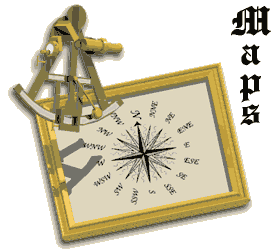
|
|
 |
|
|
|
|
|
|
|
|


More separately issued maps:
[ Saddlebag maps | Mail coach era road maps ]
[ Wall maps | Working marine charts | Political case maps ]
Other map pages: [ Locations | Map themes & related | Cartographers ]
![]()
The convenience of having maps that fold into a small size has been obvious ever since maps became items that were sold to the general public. For those wanting to take a map with them when they traveled, these maps could be slipped into a saddle-bag, pocket or suitcase. Even those who stayed in one place found that the compact size and protective covers made folding maps a practical alternative to having maps in atlases.
To simply fold a sheet of paper tended to lead to wear at the folds and corners, so at first most folding maps were made by dissecting the printed map into several sections, which were then mounted onto linen or some other cloth, with a small gap between the sections so they could be folded together without wear. While linen backed, folding maps continue to appear into the twentieth century, a new type of folding map was developed in the early nineteenth century. These maps were printed onto banknote paper, which is tough yet thin, so it could be folded without as much wear. These maps could be folded significantly smaller than the linen backed maps, and when they were protected with leather or cloth covers they became very practical cartographic documents, easy for the traveler to take with them and use on the road.
With the great increase in all means of transportation during the nineteenth century, these folding travel maps were published for the use of horse riders, wagon drivers, railroad passengers, and steamboat voyageurs. They were sold at map shops, general goods stores, inns and rail and steamboat stations to a huge population on the move. Often called "Traveler's Companions" or "Stranger's Guides," these maps are similar to today's automobile folding road maps. These maps generally had brighter hand coloring than atlas maps in order to aid in reading them under adverse circumstances. These maps usually focused on the travel nexus of roads, railroads, and steamboat routes, and they often displayed information on schedules, distances, and included inset maps of cities or smaller regions. Sometimes the maps were issued with text pages containing historical or useful travel information.
Typically these maps would have been folded and refolded, handled over and over, and stuffed into a pocket or bag. This and the roughed conditions of travel during the nineteenth century insured much wear and frequently the destruction of these documents. Thus some wear, stains or separations at the folds is to be expected, and indeed, it is somewhat surprising that any at all have survived.
More separately issued maps:
[ Saddlebag maps | Mail coach era road maps ]
[ Wall maps | Working marine charts | Political case maps ]
Other map pages: [ Locations | Map themes & related | Cartographers ]
![]()
For further information, please contact:

![]()
106 E. Lancaster Avenue, Lower Level
Wayne, PA 19087 USA
610.808.6165
PhilaPrint@PhilaPrintShop.com ![]()
©The Philadelphia Print Shop 2021